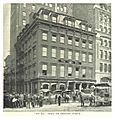Tammany Hall facts for kids
Tammany Hall was a powerful political group in New York City. It was also known as the Society of St. Tammany or the Columbian Order. This group was named after Tamanend, a respected leader of the Lenape Native American people. Tammany Hall started in 1786 and officially became the Tammany Society on May 12, 1789.
For a long time, from the 1790s to the 1960s, Tammany Hall was a big part of the Democratic Party's control over New York City politics. It also helped many immigrants, especially those from Ireland, find their way in American politics. In 1858, William Marcy Tweed became the leader of Tammany Hall.
Contents
What Was Tammany Hall?
Tammany Hall was like a very organized team that controlled politics in New York City. This kind of group is often called a "political machine." They worked to get their chosen people elected to government jobs. They also made sure their party stayed in power.
How It Helped People
Tammany Hall became very popular because it helped many people, especially new immigrants. When immigrants arrived in New York, they often faced many challenges. Tammany Hall would help them find jobs, housing, and even food. In return, these people would vote for the candidates Tammany Hall supported. This system was called "patronage," where support was given in exchange for loyalty and votes.
Famous Leaders and Challenges
One of the most famous leaders of Tammany Hall was William Marcy Tweed, often called "Boss" Tweed. He became the leader in 1858. Under his leadership, Tammany Hall became very powerful. However, it also became known for "graft," which means using political power to get money or benefits dishonestly. Many cartoons from that time showed Tammany Hall as a tiger, sometimes a sick one, because of its problems.
Its Impact on New York City
Tammany Hall played a huge role in shaping New York City. It helped many people get involved in politics who might not have had the chance otherwise. While it helped many, it also faced criticism for its methods and for being involved in corruption. Over time, its power slowly decreased, and it became less influential by the 1960s.
Images for kids
-
William M. Tweed, known as "Boss" Tweed, ran an efficient and corrupt political machine based on patronage and graft.
-
A bird's-eye-view map of New York and Brooklyn (1893), titled "A Cinch. Says Boss Croker to Boss McLaughlin: "Shake!"(The boss of Tammany Hall in New York, Richard Croker, and the boss of the Brooklyn political machine, Hugh McLaughlin, reach across the East River to shake hands in cooperation).
-
44 Union Square, the former Tammany Hall building at 17th Street and Park Avenue South, across from Union Square, housed a theatre and a film school until renovations commenced in 2016.
-
Tammany Ring by Thomas Nast; "Who stole the people's money?" / "'Twas him."
-
Tammany Hall on East 14th Street between Third Avenue and Irving Place in Manhattan, New York City (1914). The building was demolished c.1927.
See also
 In Spanish: Tammany Hall para niños
In Spanish: Tammany Hall para niños











